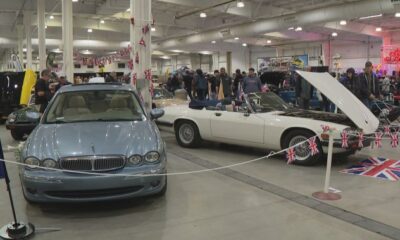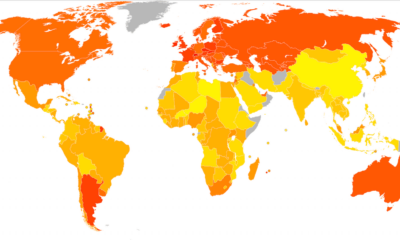Gadgets
The weird history of our dangerous relationship with uranium

This excerpt is taken from Chain Reaction: The Hopeful History of Uranium by Lucy Jane Santos, published with permission from Pegasus Books in November 2024.
In the late 1880s in the US, the La Belle Glass Company developed Ivory or Custard glass by increasing the concentration of uranium oxide, resulting in a more opaque effect. Heat-sensitive chemicals like gold were added to create a shading effect from clear yellow to milky white. Burmese glass, developed by the Mount Washington Glass company, used a recipe including uranium oxide and colloidal gold to produce opaque glass in shades from pink to yellow, possibly named after a Burmese sunset admired by Queen Victoria.
The yellowish-green effect of uranium glass became popularly known as Vaseline glass due to its resemblance to the well-known petroleum jelly brand. Many companies were using uranium to color their glass, competing to create new colors and effects in a climate of commercial secrecy.
Interestingly, in 1847, Scientific American reported that uranium, along with other substances like platina, titanium, and cobalt, was used to color artificial teeth made from feldspar and quartz. This gave the teeth an orange-yellow hue, a departure from traditional materials like ivory or metal used for dentures. The therapeutic use of toxic substances, including uranium, was also explored as a potential treatment for diseases, drawing on the principles of toxicology established by Paracelsus in the sixteenth century.
Christian Gmelin, a professor in Germany, conducted research on the toxicity of uranium salts, obtained from pitchblende, in 1824. His experiments on animals revealed the effects of uranium consumption through various methods, concluding that while uranium was a weak poison when consumed, intravenous injection proved fatal.
Further experiments by C. Le Conte in 1853 using uranium nitrate induced kidney disease in dogs, suggesting the potential for uranium to treat illnesses with similar symptoms. This research led to hope that uranium could be used in medical treatments, including for conditions like diabetes, which had been a puzzling and untreatable disease for centuries.
Overall, the history of uranium’s uses and effects reveals a complex interplay between commercial applications, scientific experimentation, and medical potential.
Diabetes Whisky, a product that offered a ‘sample on application,’ gained attention when physician Samuel West conducted clinical experiments using uranium for treating diabetes. In his trials published in the British Medical Journal in 1895 and 1896, West administered uranium salts dissolved in water to eight patients. Starting with small doses and gradually increasing to up to twenty grains multiple times a day, the treatment showed promising results. While some patients experienced improvements in symptoms and a reduction in glycosuria, others faced gastrointestinal issues, and the disease resurfaced upon discontinuation of the treatment.
Despite the inconclusive results, uranium treatments continued to be used for various ailments. From treating urinary incontinence to stomach ulcers and even haemorrhage control, uranium was incorporated into medicines like tabloids and palatinoids. One pharmaceutical company marketed palatinoids containing uranium nitrate as a remedy for diabetes, claiming to eliminate the repugnant flavor associated with West’s treatment.
In addition to conventional medications, the market also saw the introduction of medicated wine like Vin Urané Pesqui, which was touted as a powerful elixir with numerous health benefits. Patients were advised to consume three small sherry-glassfuls per day before or after meals to experience improved bodily functions, reduced fatigue, and enhanced appearance and temperament.
The history of uranium treatments, as explored in Lucy Jane Santos’s book “Half Lives: The Unlikely History of Radium,” sheds light on the cultural significance and medical experimentation of radioactive substances in the twentieth century. Santos, an expert in this field, highlights the fascinating yet unconventional approaches taken in the past to address various health conditions. Can you provide me with a rewritten version of this text?
-

 Destination8 months ago
Destination8 months agoSingapore Airlines CEO set to join board of Air India, BA News, BA
-

 Breaking News10 months ago
Breaking News10 months agoCroatia to reintroduce compulsory military draft as regional tensions soar
-

 Gadgets3 months ago
Gadgets3 months agoSupernatural Season 16 Revival News, Cast, Plot and Release Date
-

 Tech News12 months ago
Tech News12 months agoBangladeshi police agents accused of selling citizens’ personal information on Telegram
-

 Productivity11 months ago
Productivity11 months agoHow Your Contact Center Can Become A Customer Engagement Center
-

 Gadgets3 weeks ago
Gadgets3 weeks agoFallout Season 2 Potential Release Date, Cast, Plot and News
-

 Breaking News10 months ago
Breaking News10 months agoBangladesh crisis: Refaat Ahmed sworn in as Bangladesh’s new chief justice
-

 Toys12 months ago
Toys12 months ago15 of the Best Trike & Tricycles Mums Recommend























